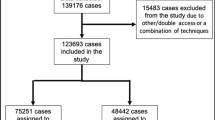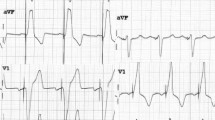Abstract
Aims
Cardiac resynchronization therapy (CRT) has growing impact in the treatment of severe heart failure Stenosis of coronary veins, complex structure of coronary sinus and occlusions of subclavian veins can limit lead passage in the target vein.
Methods and Results
Retrospective analysis of 705 implantation procedures of CRT devices from 1999 to July 2007 in a single centre to show the impact of venous angioplasty manoeuvres for successful placement of left ventricular lead. In 31 patients (3.5%) venous angioplasty was performed for LV-lead placement: 24 coronary veins (balloons 2.5–4.0mm), 4 subclavian veins, 3 valves in the coronary sinus and one Marshall vein were dilated. Ring like strictures of coronary veins made high inflation pressures (16 ± 4 atm) necessary. Success rate of LV lead placement were 99%. Complications were rare.
Conclusions
Angioplasty of coronary or subclavian veins and valve structures of coronary sinus are a useful and safe tool for successful lead placement. The use of balloons of 3.0mm in size usually allows implantation of at least a unipolar lead.




Similar content being viewed by others
References
Bleeker GB, Holman ER, Steendijk P, Boersma E, van der Wall EE, Schalij MJ, Bax JJ (2006) Cardiac resynchronization therapy in patients with a narrow QRS complex. J Am Coll Cardiol 48:2243–2250
Hansky B, Lamp B, Minami K, Heintze J, Krater L, Horstkotte D, Koerfer R, Vogt J (2002) Coronary vein balloon angioplasty for left ventricular pacemaker lead implantation. J Am Coll Cardiol 40:2144–2149
Hansky B, Vogt J, Gueldner H, Schulte-Eistrup S, Lamp B, Heintze J, Horstkotte D, Koerfer R (2007) Implantation of active fixation leads in coronary veins for left ventricular stimulation: report of five cases. Pacing Clin Electrophysiol 30:44–49
Hunt SA, Abraham T, Chin MH, Feldman AM, Francis GS, Ganiats TG, Jessup M, Konstam MA, Mancini DM, Michi K, Oates JA, Rahko PS, Silver MA, Stevenson LW, Yancy CW, Antman EM, Smith JC Jr, Adams CD, Anderson JL, Faxon DP, Fuster V, Halperin JL, Hiratazka LF, Jacobs AK, Nishimura R, Ornato JP, Page RL, Riegel B (2005) ACC/AHA 2005 guidelines update for the diagnosis and management of chronic heart failure in the adult. J Am Coll Cardiol 46:1116–1143
Kowalski O, Lenarczyk R, Prokopczuk J, Pruszkowska-Skrzep P, Zielinska T, Sredniawa B, Musialik-Lydka A, Pluta S, Kubulski T, Szulik M, Polonski L, Kalarus Z (2006) Effect of percutaneous interventions within the coronary sinus on the success rate of the implantations of resynchronization pacemakers. Pacing Clin Electrophysiol 29:1075–1080
Lemke B, Nowak B, Pfeiffer D (2005) Guidelines for heart pacemaker therapy. Z Kardiol 94:704–720
Lüdorff G, Grove R, Kranig W, Wolff E, Thale J (2008) Klinische Erfahrungen mit einer linksventrikulären Coronarsinus-Elektrode mit aktiverer Fixierung für die erfolgreiche CRT-Implantation P1193: 74. Jahrestagung Deutsche Gesellschaft für Kardiologie
McCotter CJ, Angle JF, Prudente LA, Mounsey JP, Ferguson JD, DiMarco JP, Hummel JP, Mangrum JM (2005) Placement of transvenous pacemaker and ICD leads across total chronic occlusions. Pacing Clin Electrohysiol 28:921–925
Nägele H, Azizi M, Hashagen S, Castel MA, Behrens S (2007) First experience with a new active fixation coronary sinus lead. Europace 9:437–441
Sandler DA, Feigenbaum DY, Bernstein NE, Holmes DS, Chinitz LA (2002) Cardiac vein angioplasty for biventricular pacing. Pacing Clin Electrophysiol 25:1788–1789.
Singh JP, Houser S, Heist EK, Ruskin JN (2005) The coronary venous anatomy: a segmental approach to aid cardiac resynchronization therapy. J Am Coll Cardiol 46:68–74
Stoevesandt D, Buerke M, Behrmann C, Heinroth K, Spielmann RP, Werdan K, Schlitt A (2007) Detection of persistant left superior vena cava by echocardiography, computed tomography and magnetic resonance imaging. Clin Res Cardiol 96:191–192
Swedberg K, Cleland J, Dargie H, Drexler H, Follath F, Komajda M, Tavazzi L, Smiseth OA, Gavazzi A, Haverich A, Hoes A, Jaarsma T, Korewicki J, Levy S, Linde C, Lopez-Sendon JL, Nieminen MS, Pierard L, Remme WJ (2005) Guidelines for the diagnosis and treatment of chronic heart failure: executive summary. Eur Heart J 26:1115–1140
Yu CM, Chan YS, Zhang Q, Yip GW, Chan CK, Kum LC, Wu L, Lee AP, Lam YY, Fung JW (2006) Benefits of cardiac resynchronization therapy for heart failure patients with narrow QRS complexes and coexisting systolic asynchrony by echocardiography. J Am Coll Cardiol 48:2251–2257
Acknowledgments
There was no funding or support for this study.
Conflict of interest None declared
Author information
Authors and Affiliations
Corresponding author
Rights and permissions
About this article
Cite this article
Luedorff, G., Grove, R., Kranig, W. et al. Different venous angioplasty manoeuvres for successful implantation of CRT devices. Clin Res Cardiol 98, 159–164 (2009). https://doi.org/10.1007/s00392-008-0734-x
Received:
Accepted:
Published:
Issue Date:
DOI: https://doi.org/10.1007/s00392-008-0734-x




